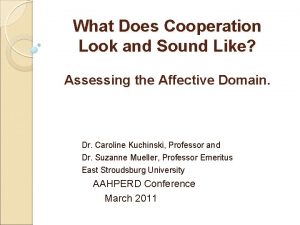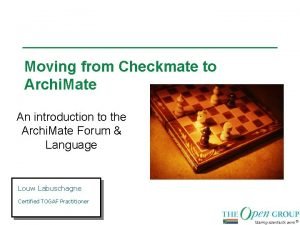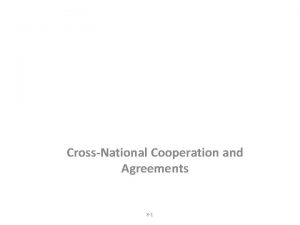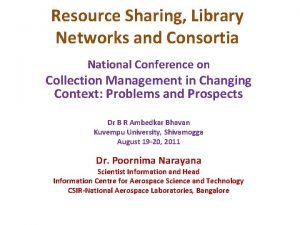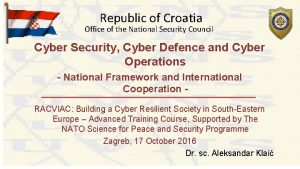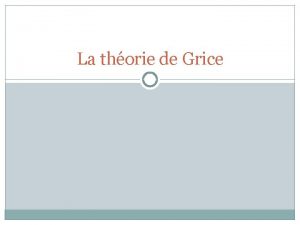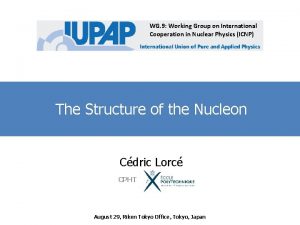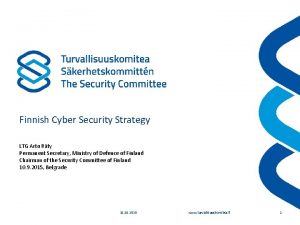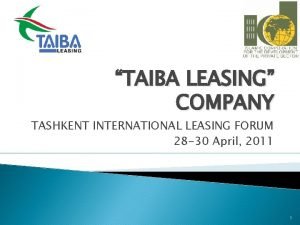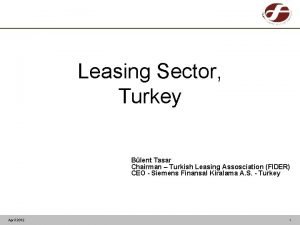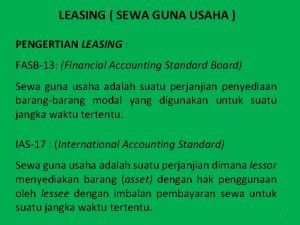Spectrum Leasing via Cooperation Osvaldo Simeone1 joint work







![Cooperation § Cooperation: “Relaying” of packets for enhanced quality-of-service [Sendonaris et al. 03]. Cooperation § Cooperation: “Relaying” of packets for enhanced quality-of-service [Sendonaris et al. 03].](https://slidetodoc.com/presentation_image_h2/6819002f0a34d79172747e29073a893d/image-8.jpg)
![Cooperation § Cooperation: “Relaying” of packets for enhanced quality-of-service [Sendonaris et al. 03]. Cooperation § Cooperation: “Relaying” of packets for enhanced quality-of-service [Sendonaris et al. 03].](https://slidetodoc.com/presentation_image_h2/6819002f0a34d79172747e29073a893d/image-9.jpg)
![Cooperation § Cooperation: “Relaying” of packets for enhanced quality-of-service [Sendonaris et al. 03]. [Cover Cooperation § Cooperation: “Relaying” of packets for enhanced quality-of-service [Sendonaris et al. 03]. [Cover](https://slidetodoc.com/presentation_image_h2/6819002f0a34d79172747e29073a893d/image-10.jpg)















































- Slides: 57

Spectrum Leasing via Cooperation Osvaldo Simeone(1) (joint work with I. Stanojev(1), Y. Bar-Ness(1), R. Pickholtz(2), U. Spagnolini(3)) (1) New Jersey Institute of Technology (2) The George Washington University (3) Politecnico di Milano, Italy

Secondary Spectrum Access (… or Cognitive Radio) § Coexistence of primary and secondary nodes in the same bandwidth: licensed (primary) users BS unlicensed (cognitive or secondary) users

Secondary Spectrum Access (… or Cognitive Radio) § Coexistence of primary and secondary nodes in the same bandwidth: licensed (primary) users BS unlicensed (cognitive or secondary) users 1) Commons model: § primary users are oblivious to the presence of secondary nodes. § the activity of the secondary users should be transparent to the primary. 2) Property-rights model (spectrum leasing): § primary users own the spectrum and can decide to lease it to secondary nodes.

Commons vs. Property-Rights § In the technical literature on communications, the commons model has been studied almost exclusively: information theory [Devroye et al. 06] [Jovicic, Viswanath arxiv], partially observable Markov chains [Zhao et al. 07], queuing theory [Simeone et al. 07]. § IEEE 802. 22 standard for Wireless Regional Area Network (WRAN) utilizing white spaces in TV bands (VHF/UHF TV bands between 54 and 862 MHz) based on the commons model. § The commons model presents very relevant implementation challenges (sensing, interference).

March 18, 2008, 6: 14 pm Going Once…Going Twice…The 700 Mhz Spectrum is Sold … After 260 rounds of bidding over more than seven weeks the government auction has ended for the 700 Mhz wireless spectrum. The winning bids totaled $19, 592, 420, 000. That’s nearly double the amount the commission had hoped to raise from the spectrum being abandoned next year as television stations switch to new frequencies. "raised more money than any [FCC] auction has ever raised"

Verizon, AT&T win FCC auction, Google wins open spectrum Thu Mar 20, 2008 7: 43 PM ET While the language of the ruling has not been made public, it appears that any company that buys the new spectrum will have to leave it open to devices it does not approve or control. … it appears to signal a shift in how policy makers and, in turn, companies, will approach access to and control of future wireless networks. The ruling did not go far enough for some consumer activist groups, but even those groups applauded parts of it. In recent weeks, Google and other technology interests pressed the commission to create an open-access wireless network — in contrast to today’s closed cellular networks — and to permit owners of the spectrum to sell portions of it wholesale to other companies.

Commons vs. Property-Rights § The property-rights model has been less studied in the communication community. § Pricing via profit maximization [Acharya and Yates 07], auction theory [Huang et al. 07] § Can the property-right model be implemented using communications technology? O. Simeone, I. Stanojev, S. Savazzi, Y. Bar-Ness, U. Spagnolini, and R. Pickholtz, "Spectrum Leasing to Cooperating Secondary Ad Hoc Networks, " IEEE Journ. Selected Areas in Communications, vol. 26, no. 1, pp. 203 -213, Jan. 2008
![Cooperation Cooperation Relaying of packets for enhanced qualityofservice Sendonaris et al 03 Cooperation § Cooperation: “Relaying” of packets for enhanced quality-of-service [Sendonaris et al. 03].](https://slidetodoc.com/presentation_image_h2/6819002f0a34d79172747e29073a893d/image-8.jpg)
Cooperation § Cooperation: “Relaying” of packets for enhanced quality-of-service [Sendonaris et al. 03].
![Cooperation Cooperation Relaying of packets for enhanced qualityofservice Sendonaris et al 03 Cooperation § Cooperation: “Relaying” of packets for enhanced quality-of-service [Sendonaris et al. 03].](https://slidetodoc.com/presentation_image_h2/6819002f0a34d79172747e29073a893d/image-9.jpg)
Cooperation § Cooperation: “Relaying” of packets for enhanced quality-of-service [Sendonaris et al. 03].
![Cooperation Cooperation Relaying of packets for enhanced qualityofservice Sendonaris et al 03 Cover Cooperation § Cooperation: “Relaying” of packets for enhanced quality-of-service [Sendonaris et al. 03]. [Cover](https://slidetodoc.com/presentation_image_h2/6819002f0a34d79172747e29073a893d/image-10.jpg)
Cooperation § Cooperation: “Relaying” of packets for enhanced quality-of-service [Sendonaris et al. 03]. [Cover and El Gamal 79]

Property-Rights Access via Cooperation § Main idea: Retribution to primary nodes for spectrum access in the form of cooperation. = § Primary nodes will be willing to lease the owned bandwidth for a fraction of time if, in exchange for this concession, they will benefit from enhanced quality-of-service thanks to cooperation with the secondary nodes. § Secondary nodes have the choice about whether to cooperate or not with the primary on the basis of the amount of cooperation required by the primary and the corresponding fraction of time leased for secondary transmissions.

Property-Rights Access via Cooperation § Cooperation and competition: - Primary-secondary cooperation - Secondary competition

A Case-Study with Centralized Control PT (primary transmitter) PR (primary receiver) ST 1 STK SR 1 SRK Set of K secondary transmission/receiver pairs § Primary transmit-receive pair that owns the spectrum and has full system information. § Ad hoc network of K secondary (competitive) communications on the same bandwidth. § Fading channels hij.

A bit of Game Theory q Non-cooperative game theory: competing decision makers. q Ex. : ST 1 h 11 h 21 SR 1 ST 2 Each link is interested in maximizing: h 12 h 22 SR 2 s. t. Rate Cost of power

A bit of Game Theory q Non-cooperative game theory: competing decision makers. q Ex. : ST 1 h 11 h 21 SR 1 Each link is interested in maximizing: ST 2 h 12 h 22 SR 2 Rate s. t. Cost of power q Nash equilibrium: no user has incentive to deviate unilaterally (best responses) Rate 2 7 6 |hii|2=1, |h–i, i|2=0. 8, c=0. 1 Pmax=20 d. B 5 4 3 2 1 00 1 2 3 4 Rate 1 5 6 7

A bit of Game Theory q Non-cooperative game theory: competing decision makers. q Ex. : ST 1 h 11 h 21 SR 1 Each link is interested in maximizing: ST 2 h 12 h 22 SR 2 Rate s. t. Cost of power q Nash equilibrium: no user has incentive to deviate unilaterally Rate 2 7 6 |hii|2=1, |h–i, i|2=0. 8, c=0. 1 Pmax=20 d. B 5 4 3 2 1 00 1 2 3 4 Rate 1 5 6 7

Spectrum Leasing via Cooperation PT PR ST 1 ST 2 ST 3 SR 1 SR 2 SR 3 T

Spectrum Leasing via Cooperation q PT communicates directly with PR for a fraction of time (1 – α). PT PR ST 1 ST 2 ST 3 SR 1 SR 2 SR 3 T

Spectrum Leasing via Cooperation q PT communicates directly with PR for a fraction of time (1 – α). q Remaining period of α can be leased to a subset of secondary that decoded the message (in exchange for cooperation). PT PR ST 1 ST 2 ST 3 SR 1 SR 2 SR 3 T

Spectrum Leasing via Cooperation q PT communicates directly with PR for a fraction of time (1 – α). q Remaining period of α can be leased to the set of secondary that decoded the message (in exchange for cooperation). q Secondary nodes transmit own data for a fraction (1 –β) of the leased time. PT PR ST 1 ST 2 ST 3 SR 1 SR 2 SR 3 T

Spectrum Leasing via Cooperation q PT communicates directly with PR for a fraction of time (1 – α). q Remaining period of α can be leased to the set of secondary that decoded the message (in exchange for cooperation). q Secondary nodes transmit own data for a fraction (1 –β) of the leased time. q In the last fraction of time, primary traffic is relayed (cooperation via distributed spacetime coding) PT PR ST 1 ST 2 ST 3 SR 1 SR 2 SR 3 T

Spectrum Leasing: Primary Decision Process PR PT ST 1 SR 1 ST 2 SR 2 PT ST 1 ST 2 PR ST 3 SR 1 S SR 2 SR 3 S PT PR ST 1 ST 2 ST 3 SR 1 SR 2 SR 3 S q Primary link’s goal: maximize its own rate RP. q Optimization space: l time fraction α to be leased to the secondary network l fraction β required from secondary to cooperate l subset S of secondary terminals to receive the spectrum q Constraints: l Maximum primary transmit power Pp l Equilibrium constraint: Being competitive, the STs settle for a transmit power given by a Nash equilibrium

Spectrum Leasing: Primary Decision Process PR PT ST 1 SR 1 ST 2 SR 2 PT ST 1 ST 2 PR ST 3 SR 1 S SR 2 SR 3 S PT PR ST 1 ST 2 ST 3 SR 1 SR 2 SR 3 S

Spectrum Leasing: Primary Decision Process PR PT ST 1 SR 1 ST 2 SR 2 ST 1 ST 2 PR ST 3 SR 1 S q PT SR 2 SR 3 S PT PR ST 1 ST 2 ST 3 SR 1 SR 2 SR 3 S

Spectrum Leasing: Primary Decision Process PR PT ST 1 SR 1 ST 2 SR 2 q with ST 1 ST 2 PR ST 3 SR 1 S q PT SR 2 SR 3 S PT PR ST 1 ST 2 ST 3 SR 1 SR 2 SR 3 S

Spectrum Leasing: Secondary Decision Process PR PT ST 1 SR 1 ST 2 SR 2 PT ST 1 ST 2 PR ST 3 SR 1 S SR 2 SR 3 S PT PR ST 1 ST 2 ST 3 SR 1 SR 2 SR 3 S q If selected by the primary, the secondary can decide how much power to employ. q This decision is made competitively by the secondary transmitters. q Optimization criterion: maximize own rate discounted by the cost of transmission power q Constraints: l Maximum secondary power l Leasing parameters (α, β) selected by the primary.

Spectrum Leasing: Secondary Decision Process PR PT ST 1 SR 1 ST 2 SR 2 ST 1 ST 2 PR ST 3 SR 1 S q PT SR 2 SR 3 S PT PR ST 1 ST 2 ST 3 SR 1 SR 2 SR 3 S

Spectrum Leasing: Secondary Decision Process PR PT ST 1 SR 1 ST 2 SR 2 PT ST 1 ST 2 PR ST 3 SR 1 S SR 2 SR 3 S PT PR ST 1 ST 2 ST 3 SR 1 SR 2 SR 3 S q Non-cooperative game. q Equilibrium solution provided by the Nash equilibrium: The powers selected by the secondary nodes selected by the primary are such that no secondary has any incentive to change its power if the others don’t.

A System View of the Decision Process Primary Secondary 1 max Rp Pi … … K q Hierarchical decision process q Stackelberg game: l Primary is the leader (with α, β and S as the playing strategy). l Secondary network is the follower (with transmitting powers as the strategy). l The leader can predict the behavior of the follower

Some Analytical Results Proposition 1: The power control game at the secondary network has always a NE. Moreover, a sufficient condition for the NE to be unique is

Some Analytical Results Proposition 1: The power control game at the secondary network has always a NE. Moreover, a sufficient condition for the NE to be unique is Proposition 2: The optimal fraction of time α leased for secondary transmission and cooperation is strictly positive if and only if there exists a subset of secondary nodes S such that the following condition is satisfied where the optimal β is the solution of the optimization problem Moreover, conditioned on (*) (i. e. , on α>0), the optimal fraction α for a given subset S reads

Some Numerical Results PT ST 1 SR 1 ST 2 SR 2 . . . ST 5 q Path loss model (exp=2) and Rayleigh fading. q Pp=1, SNR=Pp/N₀=0 d. B, c=0. 1, K=5 and g. S=10 d. B. SR 5 PR

Some Numerical Results Average Achievable Rate, Rcoop 1. 4 1. 2 a = 3/ 8 a = 1/ 2 1 a = 5/8 Rdir a=0 0. 8 a = 3/ 4 0. 6 a = 1/ 4 0. 4 a = 7/8 a = 1/ 8 0. 2 0. 1 0. 2 0. 3 0. 4 0. 5 0. 6 0. 7 0. 8 0. 9 Normalized distance, d … as the distance d increases, the optimal α decreases.

Some Numerical Results 0. 9 0. 8 b g. S = 5, 10, 20 d. B 0. 7 ab ˆ , ˆ 0. 6 0. 5 aˆ g. S = 5, 10, 20 d. B 0. 4 0. 3 0. 2 0. 1 0. 2 0. 3 0. 4 0. 5 0. 6 Normalized distance, d 0. 7 0. 8 0. 9

Some Numerical Results 1. 6 S Average Achievable Rate, RP 1. 5 S PS 1. 4 1. 3 SPS (2) 1. 2 SPS (3) SPS (1) SPS (4) 1. 1 SPS (5) 1 0. 9 0. 1 0. 2 0. 3 0. 4 0. 5 0. 6 0. 7 0. 8 0. 9 Normalized distance, d … for large distances it is more convenient to cooperate only with the secondary users with the best instantaneous channel, exploiting multiuser diversity.

Some Numerical Results Average Secondary Rate, a(1 -ß)Ri 0. 4 g. S = 20 d. B 0. 35 0. 3 g. S = 15 d. B 0. 25 0. 2 g. S = 10 d. B 0. 15 g. S = 5 d. B 0. 1 0. 05 0 0. 1 0. 2 0. 3 0. 4 0. 5 0. 6 0. 7 0. 8 0. 9 1 Normalized distance, d Since a larger distance entails a smaller optimal leased time α, the secondary rate decreases as the distance increases.

Protocol Overhead q Control channel need for the primary link to collect: - number and identity of secondary nodes - Channel State Information (CSI) parameters. … The need for a control channel is the price to be paid for the implementation of spectrum leasing (? ).

Alleviating the Protocol Overhead q No a priori knowledge of available secondary users and CSI. q Decentralized and opportunistic spectrum leasing based on HARQ and auction theory. q Fixed-rate transmission for both primary ( ) and secondary ( ). Igor Stanojev, Osvaldo Simeone, Umberto Spagnolini, Yeheskel Bar-Ness and Raymond L. Pickholtz, “An Auction-Based Spectrum Leasing Approach to Cooperative ARQ”, submitted.

Spectrum Leasing via HARQ and Auctions (Fixed) Primary Rate AP (PR and SR) PT ST 1 ST 2 q Some STs may decode the primary packet.

Spectrum Leasing via HARQ and Auctions (Fixed) Primary Rate Χ PT ST 1 AP (PR and SR) ST 2 NACK + Pilots q Some STs may decode the primary packet. q Based on the piggybacked pilots, PT and STs can estimate their CSI to the AP: ( outdating, estimation error )

Spectrum Leasing via HARQ and Auctions q Based on the estimated CSI, PT and STs can calculate the success probability to ^ the AP: Pr[current supported rate > R 0, P| h] p*1 ST 1 AP p*2 PT p 0 success prob direct transmission ST 2 success prob relayed transmission (bids)

Spectrum Leasing via HARQ and Auctions q Based on the estimated CSI, PT and STs can calculate the success probability to ^ the AP: Pr[current supported rate > R 0, P| h] p*1 ST 1 AP p*2 PT po success prob direct transmission ST 2 success prob relayed transmission (bids) q Auction: The primary select the user with the largest bid. reject ST 1 PT ST 2

Spectrum Leasing via HARQ and Auctions q Calculating the bid: Trade-off between bid (primary reliability) and reliability for secondary transmission: αi Primary data: success prob pi Ebid, i 1 -αi Ei-Ebid, i q Secondary strategy (resource allocation on type of auction and secondary preferences. Secondary data: success prob qi given channel estimate) depends q Examples: max probability of winning auction s. t. min reliability, first vs. secondprince (Vickrey auctions)…

Formulation as Bayesian Game The Bayesian game is defined by with

Formulation as Bayesian Game

Dominant Strategy Equilibrium Dominant equilibrium strategy: The strategy of each relay is a best response against any realization of the opponent types and corresponding strategies. Proposition 3: The game at hand (Vickrey auctions) admits a a dominant strategy equilibrium with strategy chosen by the relay Rk being given by: and the bid submitted by the relay is

After the Auction At the end of the auction process, the winning relay is required to guarantee the second largest primary reliability. It can thus re-adjust its transmission parameters as

Spectrum Leasing via HARQ and Auctions pk=fk(qk) f 2(q) (profit of winning secondary) p*2 p*1 f 1(q) pmin q 1, min q 2 q

Some Numerical Results 20 SNR=-7 d. B, qmin=0 (best effort), R 0, P=R 0, S=1 ρ=0. 5 E[TP] K=0, 1 K=2 10 K=4 K=8 Vickrey auction 0 20 Average number of retransmissions E[TS] K=4 10 K=2 K=1 0 0 0. 2 0. 4 0. 6 Normalized distance, d 0. 8 1

Some Numerical Results 20 SNR=-7 d. B, qmin=0. 3 R 0, P=R 0, S=1 ρ=0. 5 E[TP] K=1 K=2 10 K=4 Vickrey First-price 0 K=8 Average number of retransmissions 20 E[TS] K=4 10 K=2 K=1 0 0 0. 2 0. 4 0. 6 Normalized distance, d 0. 8 1

Concluding remarks § Can the property-right model of secondary spectrum access be implemented based on communications technology? § Yes, by exploiting cooperation for remuneration. § Analysis of a baseline case study based on Stackelberg games. § Decentralized and opportunistic implementation with low overhead via HARQ and auctions. O. Simeone, I. Stanojev, S. Savazzi, Y. Bar-Ness, U. Spagnolini, R. Pickholtz, “Spectrum leasing to cooperating ad hoc secondary networks, ” IEEE Journ. Selected Areas Commun. , vol. 26, no. 1, pp. 203 -213, Jan. 2008. I. Stanojev, O. Simeone, Y. Bar-Ness, U. Spagnolini, R. Pickholtz, “An Auction-Based Spectrum Leasing Approach to Cooperative ARQ, ” submitted. osvaldo. simeone@njit. edu

Extra Slides

Randomized Distributed Space-Time Codes PT ST 1 ST 2 ST 3 SR 1 SR 2 SR 3 q L spatial dimension L, temporal dimension q Ci [Sirkeci-Mergen and Scaglione 07]

Primary Decision Process with no CSI q The primary attempts to minimize the outage probability (for given BER requirement). q Ci is a space-time codebook, taken from a list of available codes spatial dimension L, temporal dimension q q With randomized distributed space-time codes, each active secondary chooses a codeword randomly from Ci

Some numerical results PT ST 1 SR 1 ST 2 SR 2 ST 3 SR 3 PR q Path loss model (exp=2) and Rayleigh fading. q N 0=1, target rate Rp=0. 3, target BER 10 -3, number of symbols per slot NS=80 and energy cost c=0. 1.

Some numerical results 0 10 Average Outage Probability a =1/ 8 -1 10 -2 10 -3 10 a=0 P out, dir a = 7/8 a =1/ 4 a = 3/8 a = 5/8 a = 3/ 4 -4 10 a = 1/ 2 K = 10, b = 0. 8 -5 10 0. 2 0. 3 0. 4 0. 5 0. 6 0. 7 0. 8 0. 9 Normalized distance, d … the optimal fraction of leased time α tends to decrease for increasing distance d.

 Miguel treviño morales
Miguel treviño morales Osvaldo dragun biografia
Osvaldo dragun biografia Marcelo osvaldo lucentini
Marcelo osvaldo lucentini Circolo didattico giovanni pascoli grumo nevano
Circolo didattico giovanni pascoli grumo nevano Osvaldo rudloff
Osvaldo rudloff Chromium orbital configuration
Chromium orbital configuration Absorption spectrum vs emission spectrum
Absorption spectrum vs emission spectrum Via crucis y via lucis
Via crucis y via lucis Via negativa
Via negativa 14 estacion del via lucis
14 estacion del via lucis Lesion primera y segunda motoneurona
Lesion primera y segunda motoneurona Via erudita e via popular
Via erudita e via popular Grades of lamb
Grades of lamb Hyaline cartilage vertebrae
Hyaline cartilage vertebrae Permanent fastening methods
Permanent fastening methods Appretaite
Appretaite Break joint vs spool joint
Break joint vs spool joint Fibrous joints
Fibrous joints What does cooperation look like
What does cooperation look like Conflict interaction examples
Conflict interaction examples International laboratory accreditation cooperation
International laboratory accreditation cooperation European cooperation for accreditation
European cooperation for accreditation Cooperation relationship ecosystem
Cooperation relationship ecosystem Cooperation offer
Cooperation offer Interamerican accreditation cooperation
Interamerican accreditation cooperation Asia pacific economic cooperation forum
Asia pacific economic cooperation forum Unit 4 task 2
Unit 4 task 2 Cooperation social interaction
Cooperation social interaction Pics abbreviation in pharma
Pics abbreviation in pharma Archi visio
Archi visio Communication coordination cooperation during the emergency
Communication coordination cooperation during the emergency Blueprint for sectoral cooperation on skills
Blueprint for sectoral cooperation on skills Communication cooperation coordination collaboration
Communication cooperation coordination collaboration Agriculture cooperation and farmers welfare
Agriculture cooperation and farmers welfare Apec food safety cooperation forum
Apec food safety cooperation forum Mutual cooperation agreement template
Mutual cooperation agreement template Cross national cooperation
Cross national cooperation Collaboration or cooperation
Collaboration or cooperation Economic cooperation examples
Economic cooperation examples Christianity
Christianity Library cooperation
Library cooperation Nis cooperation group
Nis cooperation group Maximes conversationnelles
Maximes conversationnelles Evaluation cooperation group
Evaluation cooperation group Labour management cooperation
Labour management cooperation Working group on international cooperation
Working group on international cooperation International laboratory accreditation cooperation
International laboratory accreditation cooperation Civil cooperation bureau
Civil cooperation bureau What is one way that cooperation helps lions to survive
What is one way that cooperation helps lions to survive Cyber cooperation
Cyber cooperation Atılım üni erasmus
Atılım üni erasmus Erasmus mundus external cooperation window
Erasmus mundus external cooperation window Cyber cooperation
Cyber cooperation Itau
Itau European fleet leasing market
European fleet leasing market Equipment leasing 101
Equipment leasing 101 Solar installation summit county
Solar installation summit county Solar leasing business model
Solar leasing business model


















